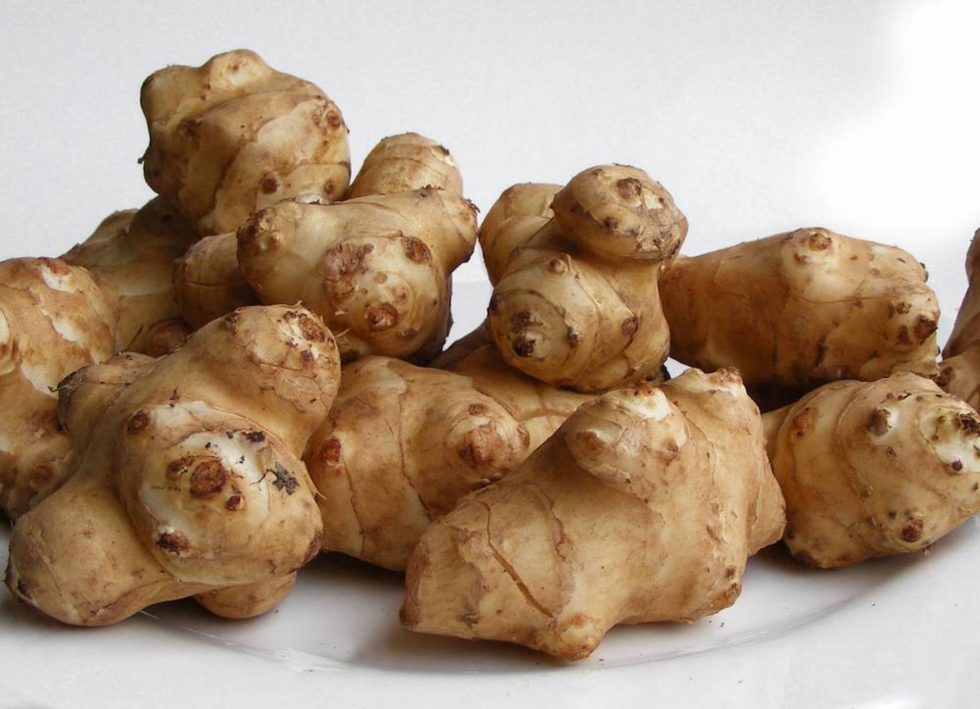Health
Growing Sunchokes- An Edible Landscape Plant
Published
3 months agoon
By
Jackson
Sunchokes, also known as Jerusalem artichokes, are an increasingly popular addition to edible landscapes. With their sunflower-like blooms and knobby tubers, sunchokes (Helianthus tuberosus) offer both aesthetic appeal and a nutritious harvest. This hardy perennial is native to North America and is celebrated for its low maintenance requirements and versatility in the garden. This article delves into the benefits, cultivation, and uses of sunchokes, making the case for why they deserve a spot in your garden.
What Are Sunchokes?
Despite their name, sunchokes are not related to artichokes nor do they originate from Jerusalem. The name “Jerusalem artichoke” is thought to be a corruption of the Italian word for sunflower, “girasole.” Sunchokes are a type of sunflower, but instead of being cultivated for their seeds, they are grown for their edible tubers, which resemble ginger root in appearance. These tubers are rich in inulin, a type of carbohydrate that is particularly beneficial for those managing blood sugar levels, making sunchokes a great choice for diabetics.
The Aesthetic Appeal of Sunchokes
Incorporating sunchokes into an edible landscape is an excellent way to blend beauty and functionality. The plants can reach heights of 6 to 10 feet, creating a striking visual impact with their tall, sturdy stems topped with bright yellow flowers that resemble small sunflowers. These flowers bloom in late summer to early fall, providing a splash of color at a time when many other garden plants are starting to fade. The tall, dense growth habit of sunchokes also makes them an effective natural screen or windbreak in the garden.
Growing Conditions and Planting
Sunchokes are remarkably easy to grow and thrive in a variety of conditions, making them an ideal choice for both novice and experienced gardeners. Here’s a breakdown of the key growing requirements for sunchokes:
- Soil: Sunchokes are adaptable to different soil types, but they prefer well-drained, loose soil with a pH between 5.8 and 6.5. While they can grow in poorer soils, rich, sandy loam will yield the best tuber production. It’s important to avoid waterlogged soils, as this can lead to rotting of the tubers.
- Sunlight: These sun-loving plants require full sun to thrive. Ensure that they receive at least 6 to 8 hours of direct sunlight per day. While they can tolerate some light shade, full sun will maximize their growth and tuber production.
- Watering: Sunchokes have moderate water needs. They should be watered regularly, especially during dry periods, but they are somewhat drought-tolerant once established. Overwatering can lead to tuber rot, so it’s crucial to find a balance, keeping the soil consistently moist but not waterlogged.
- Planting: Sunchokes are typically planted in the spring after the last frost. The tubers, which resemble small potatoes, should be planted 3 to 5 inches deep and spaced 12 to 18 inches apart. If you are planting multiple rows, allow at least 2 feet between rows to accommodate their expansive growth. Because sunchokes can spread aggressively, it’s advisable to plant them in a contained area or use a root barrier to prevent them from overtaking other garden plants.
Care and Maintenance
Once established, sunchokes require minimal care, making them an excellent choice for low-maintenance gardens. Here are some tips to keep your sunchokes healthy and productive:
- Mulching: Applying a layer of organic mulch around the plants helps retain soil moisture, suppress weeds, and regulate soil temperature. Mulch also gradually breaks down, adding organic matter to the soil.
- Fertilization: Sunchokes are not heavy feeders, but a light application of compost or a balanced organic fertilizer in the spring can encourage healthy growth and increased tuber production.
- Pruning: Regular pruning is not necessary for sunchokes, but you can pinch back the growing tips in early summer to encourage bushier growth and prevent the plants from becoming too tall and leggy. Removing spent flowers will also help the plants conserve energy for tuber production.
- Pest and Disease Control: Sunchokes are generally resistant to pests and diseases. However, they can occasionally be affected by aphids, slugs, or powdery mildew. Regular monitoring and the application of organic pest controls, such as neem oil or insecticidal soap, can help manage these issues.
Harvesting Sunchokes
One of the most rewarding aspects of growing sunchokes is the harvest. The tubers are typically ready to be harvested in late fall, after the first frost has killed back the foliage. This frost exposure actually improves the flavor of the tubers, making them sweeter and less starchy.
To harvest, carefully dig around the base of the plants with a garden fork, being mindful not to damage the tubers. Sunchokes can be harvested as needed throughout the winter, as long as the ground is not frozen. Any tubers left in the ground will overwinter and sprout new plants in the spring.
Culinary Uses
Sunchokes are incredibly versatile in the kitchen. Their nutty, slightly sweet flavor and crisp texture make them a delightful addition to a variety of dishes. Here are some ways to enjoy sunchokes:
- Raw: Sunchokes can be eaten raw, sliced thinly and added to salads for a crunchy, refreshing bite.
- Roasted: Roasting sunchokes brings out their natural sweetness. Toss them with olive oil, salt, and herbs, then roast in the oven until golden and crispy.
- Soups and Stews: Sunchokes add a creamy texture to soups and stews. They can be used in place of potatoes or alongside other root vegetables.
- Pickled: Pickling sunchokes is a great way to preserve their flavor and add a tangy crunch to sandwiches, salads, or charcuterie boards.
Health Benefits
Sunchokes are not only delicious but also packed with nutrients. They are an excellent source of dietary fiber, particularly inulin, which acts as a prebiotic, promoting gut health. Inulin also has a low glycemic index, making sunchokes a good option for people with diabetes. Additionally, sunchokes are rich in iron, potassium, and B vitamins, contributing to overall health and well-being.
Environmental Benefits
Beyond their culinary and health benefits, sunchokes also offer environmental advantages. As a native plant, they support local ecosystems by providing food and habitat for pollinators such as bees and butterflies. Their deep root systems help improve soil structure and prevent erosion, making them a valuable addition to sustainable landscapes.
Conclusion
Sunchokes are a remarkable plant that deserves more recognition in edible landscaping. Their striking appearance, ease of cultivation, and versatile culinary uses make them an ideal choice for gardeners looking to combine beauty and utility. Whether you’re an experienced gardener or just starting out, growing sunchokes can provide a bountiful and rewarding harvest, all while enhancing the aesthetics and sustainability of your garden. So why not give sunchokes a try? You may find that these humble tubers quickly become one of your favorite garden plants.
FAQS
1. What are sunchokes?
Sunchokes, also known as Jerusalem artichokes, are a type of sunflower (Helianthus tuberosus) grown for their edible tubers. They have a nutty, slightly sweet flavor and can be eaten raw or cooked. Sunchokes are a versatile addition to edible landscapes, offering both ornamental value with their bright yellow flowers and practical value with their nutritious tubers.
2. Why should I grow sunchokes in my landscape?
Sunchokes are a great choice for edible landscaping because they are low-maintenance, drought-tolerant, and produce attractive flowers that add visual interest to your garden. Additionally, they provide a reliable source of food, as their tubers are nutritious and can be harvested in late fall or early winter.
3. How do I plant sunchokes?
Plant sunchoke tubers in early spring or late fall. Choose a sunny location with well-drained soil. Dig holes 4-6 inches deep and space the tubers 12-18 inches apart. Cover them with soil and water well. Sunchokes will grow tall, so plant them where they won’t shade out other plants.
4. What soil conditions do sunchokes prefer?
Sunchokes thrive in well-drained, sandy loam soil but are adaptable to a range of soil types, including clay and poor soils. They prefer slightly acidic to neutral soil pH (6.0-7.5). Adding compost to the planting area can improve soil fertility and drainage.
5. How much sunlight do sunchokes need?
Sunchokes require full sun for optimal growth, meaning they need at least 6-8 hours of direct sunlight per day. They can tolerate partial shade but may produce fewer flowers and tubers under those conditions.
6. How do I care for sunchokes during the growing season?
Sunchokes are relatively low-maintenance. Water them regularly, especially during dry spells, but avoid overwatering. Mulching around the plants can help retain soil moisture and suppress weeds. You can also stake the plants if they become too tall and start to lean.
7. When and how do I harvest sunchokes?
Sunchokes are ready to harvest after the first frost, which sweetens the tubers. Use a garden fork to carefully dig up the tubers, starting about 12 inches away from the base of the plant to avoid damaging them. You can leave some tubers in the ground to regrow the following year.
8. Can sunchokes become invasive?
Yes, sunchokes can spread aggressively if not managed properly. To prevent them from taking over your garden, harvest all the tubers at the end of the season or grow them in a contained area, such as a raised bed or a large container.
9. How do I store harvested sunchokes?
Store sunchokes in a cool, dark, and humid place, like a root cellar or a refrigerator. They can be kept in plastic bags or containers with damp sand or sawdust to maintain humidity. Freshly harvested tubers will last for several weeks, but their texture can become softer over time.
10. Are there any pests or diseases that affect sunchokes?
Sunchokes are generally pest-resistant, but they can occasionally be affected by aphids, slugs, or powdery mildew. Regular inspection and good garden hygiene can help prevent these issues. If you notice pests, use organic methods such as insecticidal soap or handpicking to control them.
11. Can sunchokes be grown in containers?
Yes, sunchokes can be grown in large containers, which can help control their spread. Choose a container at least 18 inches deep with good drainage. Fill it with a rich, well-drained potting mix and plant the tubers as you would in the ground. Be sure to water regularly, as containers dry out more quickly than garden beds.
12. Do sunchokes have any culinary uses?
Sunchokes are versatile in the kitchen. They can be eaten raw in salads, roasted, sautéed, mashed, or even pickled. Their nutty, slightly sweet flavor complements a variety of dishes, and they can be used as a substitute for potatoes or other root vegetables.
13. Are sunchokes good for my health?
Sunchokes are rich in inulin, a type of dietary fiber that acts as a prebiotic, promoting healthy gut bacteria. They are also low in calories, high in potassium, and contain iron, magnesium, and vitamin C. However, some people may experience digestive discomfort after eating large amounts of sunchokes, so it’s best to start with small portions.
14. What are the companion plants for sunchokes?
Sunchokes grow well with nitrogen-fixing plants like beans and peas, which can improve soil fertility. They can also be planted alongside corn, as their tall stalks can provide support for climbing plants like beans. Avoid planting sunchokes near root vegetables like carrots and beets, as they may compete for underground space.
15. Can I grow sunchokes indoors?
While it is possible to grow sunchokes indoors, they are large plants that require significant space and sunlight, making them better suited for outdoor cultivation. If growing indoors, ensure they have ample light and a large container to accommodate their roots.
You may like
Health
Elevate Your Health: The WellHealthOrganic Buffalo Milk Tag Difference
Published
3 months agoon
August 22, 2024By
Jackson
Buffalo milk has been a staple in many cultures for centuries, revered for its rich taste and nutritional benefits. But what if we told you that not all buffalo milk is created equal? Enter the WellHealthOrganic Buffalo Milk Tag—a game-changer in the world of health and wellness. This article will delve into the unique benefits of WellHealthOrganic Buffalo Milk, exploring how it stands out from the rest and why it should be a part of your daily diet.
What is WellHealthOrganic Buffalo Milk Tag?
The WellHealthOrganic Buffalo Milk Tag represents a commitment to quality, purity, and nutrition. It’s not just about selling buffalo milk; it’s about providing a product that meets the highest standards of organic farming and animal care. The tag signifies that the milk you consume is free from harmful chemicals, hormones, and preservatives, making it a healthier option for you and your family.
The Origins of WellHealthOrganic Buffalo Milk
WellHealthOrganic sources its buffalo milk from small, organic farms where buffaloes are raised in a stress-free environment. These buffaloes are fed a natural diet, free from synthetic additives, which ensures that the milk they produce is as pure as possible. The focus on ethical farming practices means that the buffaloes are treated with care, and their well-being is prioritized, which in turn affects the quality of the milk.
Nutritional Benefits of WellHealthOrganic Buffalo Milk
Buffalo milk is known for its rich, creamy texture and higher fat content compared to cow’s milk. But there’s more to it than just taste. Let’s explore the nutritional benefits that set WellHealthOrganic Buffalo Milk apart.
1. Higher Protein Content
Buffalo milk contains more protein than cow’s milk, making it an excellent choice for those looking to build muscle or maintain a protein-rich diet. The higher protein content also aids in the repair of body tissues and supports overall growth and development.
2. Rich in Calcium
Calcium is crucial for strong bones and teeth, and buffalo milk is a great source of this essential mineral. WellHealthOrganic Buffalo Milk provides a higher calcium content than cow’s milk, making it an ideal choice for individuals of all ages, particularly children and the elderly.
3. Good Source of Vitamins
Buffalo milk is packed with essential vitamins such as Vitamin A, Vitamin D, and Vitamin B12. These vitamins play a key role in maintaining healthy skin, boosting immunity, and supporting neurological function. The WellHealthOrganic Buffalo Milk Tag ensures that these vitamins are preserved in their natural state, without the interference of artificial additives.
4. Lower Cholesterol Levels
Contrary to popular belief, buffalo milk contains lower cholesterol levels compared to cow’s milk. This makes it a heart-friendly option, particularly for those who need to monitor their cholesterol intake. WellHealthOrganic’s commitment to organic farming further reduces any risks associated with consuming buffalo milk.
5. Rich in Antioxidants
Buffalo milk is a natural source of antioxidants, which help fight off free radicals in the body. Free radicals can cause oxidative stress, leading to various chronic diseases. The antioxidants present in WellHealthOrganic Buffalo Milk help in reducing this risk, promoting overall health and well-being.
The WellHealthOrganic Difference: Why Choose Us?
1. Organic and Pure
At WellHealthOrganic, the focus is on purity. The buffalo milk is 100% organic, meaning it is free from synthetic chemicals, pesticides, and GMOs. This ensures that you are consuming a product that is not only safe but also beneficial for your health.
2. Ethical Farming Practices
WellHealthOrganic is committed to ethical farming practices. The buffaloes are raised in a natural environment, free from stress and harm. They are not subjected to growth hormones or antibiotics, which can be harmful to both the animals and the consumers.
3. Sustainability
Sustainability is at the heart of WellHealthOrganic. The farming practices used are environmentally friendly, ensuring that the land, water, and resources are preserved for future generations. By choosing WellHealthOrganic Buffalo Milk, you are not only taking care of your health but also contributing to the well-being of the planet.
4. Transparency
With WellHealthOrganic, what you see is what you get. The company is transparent about its sourcing, farming practices, and product ingredients. This transparency builds trust, ensuring that you can make informed choices about what you consume.
How to Incorporate WellHealthOrganic Buffalo Milk into Your Diet
Buffalo milk is incredibly versatile and can be used in various ways in your daily diet. Here are some ideas:
1. Morning Coffee or Tea
Replace your regular milk with WellHealthOrganic Buffalo Milk in your morning coffee or tea. The rich, creamy texture enhances the flavor, making your beverage more enjoyable.
2. Smoothies and Shakes
Add a nutrient boost to your smoothies and shakes by using WellHealthOrganic Buffalo Milk. Its high protein content makes it a great post-workout drink, helping in muscle recovery.
3. Cooking and Baking
Buffalo milk can be used in cooking and baking, just like cow’s milk. Whether you’re making pancakes, cakes, or savory dishes, the WellHealthOrganic Buffalo Milk Tag ensures that your meals are both delicious and nutritious.
4. Cheese and Yogurt
Buffalo milk is often used to make mozzarella cheese and yogurt, both of which are rich in probiotics. These can be a healthy addition to your meals, improving gut health and digestion.
Conclusion
The WellHealthOrganic Buffalo Milk Tag Difference is more than just a label; it’s a promise of quality, health, and sustainability. By choosing WellHealthOrganic Buffalo Milk, you are opting for a product that is not only rich in nutrients but also ethically produced and environmentally friendly. Elevate your health today by making WellHealthOrganic Buffalo Milk a part of your daily diet.
Health
The Juicy World of μηλε: Exploring the Essence of Apples
Published
3 months agoon
August 19, 2024By
Jackson
Welcome to the juicy world of μηλε apples, where this beloved fruit takes center stage in our kitchens, beauty routines, and beyond. From their rich history to diverse varieties and countless health benefits, apples truly are nature’s gift that keeps on giving. Join us on a flavorful journey as we explore the essence of apples and all the wonderful ways they enhance our lives!
The History and Origin of Apples
The history of apples traces back thousands of years, with origins believed to be in the region of modern-day Kazakhstan. Wild apples were first cultivated by ancient civilizations like the Greeks and Romans, who valued them for their versatility and flavor.
Apples have been woven into mythology and folklore, often symbolizing love, temptation, and immortality. The famous tale of Newton’s discovery of gravity under an apple tree has become ingrained in popular culture.
Over time, different varieties of apples emerged through selective breeding, leading to the diverse range we enjoy today. From sweet Honeycrisps to tart Granny Smiths, each type offers a unique taste experience.
As apples spread across the globe, they became a staple in various cuisines and traditions. Their enduring popularity is a testament to their timeless appeal and adaptability throughout history.
Nutritional Benefits of μηλε Apples
When it comes to nutrition, μηλε apples are a powerhouse fruit packed with essential vitamins and minerals. They are low in calories but high in fiber, making them a great choice for those looking to maintain a healthy weight or improve digestion.
Apples contain antioxidants like quercetin and catechin that may help reduce the risk of chronic diseases such as heart disease and diabetes. The soluble fiber found in apples can also help lower cholesterol levels and regulate blood sugar levels.
Additionally, apples are rich in vitamin C, which boosts the immune system and promotes skin health. Eating an apple a day can contribute to overall well-being by providing your body with essential nutrients it needs to thrive.
So next time you’re craving a snack, reach for an apple not only for its delicious taste but also for its numerous nutritional benefits that support your health from the inside out.
Different Varieties of Apples
When it comes to apples, there is a diverse range of varieties that cater to different tastes and preferences. From the sweet and crisp Honeycrisp to the tart and tangy Granny Smith, each type offers a unique flavor profile.
If you prefer a more traditional apple taste, Gala apples are a popular choice with their mild sweetness and juiciness. For those looking for an apple with a hint of spice, Fuji apples provide a perfect balance of sweetness and subtle cinnamon notes.
On the other hand, if you enjoy baking or making cider, Jonathan apples are known for their aromatic qualities and robust flavor. Pink Lady apples offer a nice crunch combined with both sweet and tart flavors which make them great for snacking or salads.
No matter your preference, exploring the various apple varieties can add excitement to your culinary experiences.
How to Choose the Perfect Apple
When it comes to choosing the perfect apple, there are a few key factors to consider.
Start by examining the skin of the apple – it should be smooth and firm without any blemishes or bruises. Next, give it a gentle squeeze in your hand to test for firmness; you want an apple that feels solid but not rock hard.
Consider the color of the apple as well – different varieties will have varying shades from bright reds to yellow-greens. Choose based on personal preference or intended use in recipes.
Smell can also play a part in selecting the ideal apple; a fresh, sweet aroma indicates ripeness and flavor. Trust your instincts and go with what feels right when picking out your apples at the grocery store or farmer’s market.
Remember, each variety offers its own unique taste and texture profile so don’t be afraid to try something new!
Cooking with Apples: Sweet and Savory Recipes
When it comes to cooking with apples, the options are endless. For a sweet treat, try making classic apple pie or apple crisp. The combination of warm cinnamon and tender apples is sure to satisfy your dessert cravings.
If you’re in the mood for something savory, incorporate apples into your main dishes. Add slices of apple to a grilled cheese sandwich for a delicious twist on a classic lunch favorite. You can also roast pork loin with apples and onions for a flavorful and hearty meal that will impress your dinner guests.
For a lighter option, consider adding diced apples to salads for a refreshing burst of sweetness. Or whip up some homemade applesauce to accompany your breakfast pancakes or as a healthy snack throughout the day.
Experimenting with different ways to cook with apples can open up a world of culinary possibilities in your kitchen.
Alternative Uses for Apples: Beauty and Household Hacks
Did you know that apples can do more than just keep the doctor away? These versatile fruits have surprising beauty and household uses beyond their delicious taste.
For a natural DIY face mask, mix mashed apple with honey and yogurt for a refreshing skin treatment. The antioxidants in apples can help rejuvenate your skin and give it a healthy glow.
Apples can also be used to freshen up your home! Boil apple peels with cinnamon sticks and cloves to create a fragrant simmer potpourri that will make your house smell like autumn all year round.
If you want shiny hair without chemicals, rinse your hair with μηλε apple cider vinegar diluted in water after shampooing. It helps remove build-up and adds shine to your locks.
Incorporating apples into your beauty routine and household chores is not only fun but also an eco-friendly way to reap the benefits of this nutritious fruit.
Conclusion: Embracing the Versatility and Health Benefits of Apples
As we delve deeper into the juicy world of μηλε apples, it becomes evident that these versatile fruits offer a plethora of health benefits and culinary possibilities. From their rich history to the various varieties available, apples have firmly established themselves as a beloved ingredient in both sweet and savory dishes.
The nutritional profile of apples is impressive, packed with essential vitamins, minerals, and antioxidants that support overall well-being. Whether enjoyed fresh as a snack or incorporated into recipes, apples can enhance our daily diet and contribute to a healthier lifestyle.
With numerous cooking options ranging from pies to salads to sauces, there’s no shortage of ways to savor the flavor of this fruit. Their natural sweetness makes them perfect for desserts while their crisp texture adds depth to savory dishes.
Beyond the kitchen, apples can also be utilized in beauty regimens and household hacks due to their skin-loving properties and practical uses. From DIY face masks to natural cleaners, these fruits continue to surprise us with their versatility.
In embracing the essence of μηλε apples, we not only celebrate their delicious taste but also acknowledge the myriad benefits they bring into our lives – from nourishing our bodies inside out to sparking creativity in our culinary endeavors.
FAQ
Q: Are all apples created equal in terms of nutrition?
A: While all apples offer health benefits, the nutritional content may vary slightly between different varieties. Some are higher in certain vitamins or antioxidants than others.
Q: Can I eat apple seeds?
A: Apple seeds contain cyanide compounds and should not be consumed in large quantities. Swallowing a few accidentally is unlikely to cause harm, but it’s best to avoid eating them intentionally.
Q: How do I store apples to keep them fresh longer?
A: Store apples in the refrigerator crisper drawer or a cool, dark place away from other fruits. To prevent browning, sprinkle some lemon juice on sliced apples before storing.
Q: What are some creative ways to use leftover apple peels and cores?
A: You can make homemade apple cider vinegar by fermenting apple scraps with water and sugar. Additionally, you can use them to infuse flavor into water or tea for a refreshing twist.
Health
An Introduction to angelicatlol facial Treatments
Published
3 months agoon
August 13, 2024By
Jackson
Are you ready to unlock the secret to radiant skin? If so, let’s dive into the world of AngelicaTLOL facial treatments. These innovative skincare solutions are gaining popularity for a reason. They offer more than just relaxation; they provide transformative benefits that can rejuvenate your complexion and elevate your self-care routine. Whether you’re looking to address specific skin concerns or simply indulge in some much-needed pampering, this guide will walk you through everything you need to know about AngelicaTLOL facials. Discover how these treatments work, their various types, and what makes them stand out in the ever-evolving beauty landscape. Your journey toward glowing skin starts here!
Understanding the Basics of AngelicaTLOL Facial Treatments
AngelicaTLOL facial treatments are designed to rejuvenate and revitalize your skin. These facials incorporate advanced techniques that cater to various skin types and concerns, making them incredibly versatile.
At the core of these treatments is the use of high-quality ingredients infused with natural extracts. This unique blend helps nourish the skin while providing essential hydration.
The process often involves deep cleansing, exfoliation, and targeted therapies tailored to individual needs. This approach not only enhances texture but also promotes a healthy glow.
Many users appreciate how AngelicaTLOL facials focus on both relaxation and results. It’s about creating a soothing experience without compromising effectiveness.
With each session, clients can expect noticeable improvements in their complexion, along with an overall sense of well-being that comes from taking time for self-care.
Different Types of AngelicaTLOL Facial Treatments
AngelicaTLOL offers a variety of facial treatments designed to cater to different skin types and concerns. Each treatment is unique, providing tailored experiences for every individual.
One popular option is the hydrating facial. This treatment focuses on replenishing moisture levels in the skin, making it ideal for those with dry or dehydrated complexions.
For those battling acne, the clarifying facial utilizes deep-cleansing techniques combined with targeted products to help clear pores and reduce breakouts effectively.
If you’re looking for rejuvenation, consider the anti-aging facial. It incorporates advanced serums and gentle exfoliation methods that promote collagen production and enhance skin elasticity.
There’s the soothing sensitivity treatment. Perfect for sensitive skin types, this option uses calming ingredients that alleviate redness while nourishing delicate areas without irritation.
Benefits of AngelicaTLOL Facial Treatments
AngelicaTLOL facial treatments offer a refreshing boost to your skincare routine. These treatments are designed to rejuvenate the skin, leaving it radiant and revitalized.
One notable benefit is their ability to hydrate deeply. This helps in plumping up fine lines and wrinkles, providing a youthful appearance.
Additionally, AngelicaTLOL facials can improve skin texture by promoting cell turnover. This leads to smoother, softer skin that feels as good as it looks.
Many clients also report reduced redness and irritation after treatment. The calming ingredients used work wonders for sensitive or acne-prone skin.
Moreover, regular sessions can enhance blood circulation in your face. Improved circulation means more nutrients reach your skin cells, promoting overall health and vibrancy.
These facials create a moment of relaxation amidst our busy lives. Taking time for self-care has positive effects on mental well-being too.
How to Prepare for an AngelicaTLOL Facial Treatment
Preparing for an AngelicaTLOL facial treatment is essential to ensure you get the most out of your experience. Start by cleansing your skin thoroughly at least a day before your appointment. This will help remove any impurities and allow the products used during the treatment to penetrate better.
Hydration plays a key role too. Drink plenty of water leading up to your session, as well-hydrated skin responds more positively to treatments. Avoid alcohol and caffeine on the day of your appointment; both can dehydrate your skin.
If you have sensitive skin or specific concerns, communicate these with your esthetician beforehand. They can tailor the treatment for optimal results.
Arrive a little early so you can relax and fill out any necessary paperwork without feeling rushed. Being calm sets a positive tone for the entire experience.
What to Expect During and After the Treatment
During an AngelicaTLOL facial treatment, you’ll first notice a soothing environment. Soft music and calming scents set the mood for relaxation.
As your esthetician begins, they’ll gently cleanse your skin to prepare it for the procedure. You might feel slight tingling or warmth as specialized products are applied, designed specifically for your skin type.
Expect personalized attention throughout the session. Your esthetician will check in with you regularly to ensure comfort.
Post-treatment, there may be some redness or sensitivity—a normal response as your skin revitalizes itself. Hydrating serums will help soothe any irritation.
You can also anticipate glowing results shortly after! Skin texture improves noticeably, leaving you radiant and refreshed. Remember to follow any aftercare advice given by your skincare professional to maintain those beautiful effects longer.
Frequently Asked Questions about AngelicaTLOL Facial Treatments
Many people have questions about AngelicaTLOL facial treatments. One common inquiry is how long the results last. Typically, results can be seen immediately and may last several weeks, depending on skin type and maintenance.
Is there any downtime? Most clients experience little to no downtime. You might notice minor redness that fades quickly.
What types of skin are suitable for these treatments? They cater to various skin types, including sensitive or acne-prone skin. A consultation can help tailor the treatment to your needs.
Are the products used safe? Yes, all formulations undergo rigorous testing for safety and effectiveness before application.
Can I combine it with other beauty treatments? Absolutely! Many find great success by integrating AngelicaTLOL facials into their existing skincare routines.
How often should one get these facials? Regular sessions every 4-6 weeks typically yield the best results for maintaining healthy skin.
Conclusion
Angelicatlol facial treatments have gained popularity for their unique approach to skin care. These treatments are designed to cater to various skin types and concerns, offering a personalized experience for each individual. With numerous options available, from rejuvenating masks to advanced techniques, there’s something suitable for everyone.
The benefits of these facials extend beyond mere aesthetics. Many clients report improved skin texture, hydration levels, and an overall glow after their sessions. Additionally, the relaxing atmosphere often associated with angelicatlol facials can provide mental wellness alongside physical improvements.
To make the most out of your experience, preparation is key. Arriving with clean skin and a clear understanding of what you hope to achieve will enhance the efficacy of your treatment. During the session itself, expect a thorough consultation followed by tailored procedures that suit your specific needs.
Trending
-

 Marketing5 months ago
Marketing5 months agoExploring the World of “Валерко Логвин Архив”
-

 News5 months ago
News5 months agoDiscover Cyberkannadig: The Future of Kannada in the Digital Age
-

 THC5 months ago
THC5 months agoThe Comprehensive Guide to THC: What You Need to Know
-

 Marketing5 months ago
Marketing5 months agoCoomersu: The Community-Powered Future of Online Shopping
-

 News4 months ago
News4 months agoDadiyanki: The Man Behind the Reggaeton Mask
-

 News1 month ago
News1 month agoMahimagicdoll999999 Archives: A Comprehensive Insight
-

 CBD5 months ago
CBD5 months agoEverything You Need to Know About CBD Pens: A Comprehensive Guide
-

 News4 weeks ago
News4 weeks agoNewztalkies.com is Your Ultimate News Hub
